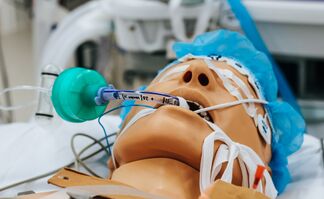Coma: Difference between revisions
No edit summary |
No edit summary |
||
| Line 8: | Line 8: | ||
Coma is widely encountered throughout health care settings and may occur in the context of a variety of different acute [[Neurological Disorders|neurological disorders.]]<ref name=":3" /> | Coma is widely encountered throughout health care settings and may occur in the context of a variety of different acute [[Neurological Disorders|neurological disorders.]]<ref name=":3" /> | ||
A coma is a prolonged state of unconsciousness. During a coma, a person is unresponsive to their environment<ref name=":1" />. | A coma is a prolonged state of unconsciousness. During a coma, a person is unresponsive to their environment<ref name=":1" />. The person is alive and looks like they are sleeping, but unlike in a deep sleep, the person cannot be awakened by any stimulation, including pain. | ||
* | * Causes of coma range from easily correctable metabolic abnormalities to catastrophic life-threatening mass lesions. | ||
* Coma is usually a transitory state though it may last for an indefinite or even prolonged period.<ref name=":0">Huff JS, Tadi P. [https://www.ncbi.nlm.nih.gov/books/NBK430722/ Coma].[Updated 8 July 2021]. StatPearls [Internet]; StatPearls Publishing: Treasure Island, FL, USA. 2021. Available: https://www.ncbi.nlm.nih.gov/books/NBK430722/ (accessed 19.5.2022)</ref><ref name=":1">Web md Coma: Types, Causes, Treatments, Prognosis Available: https://www.webmd.com/brain/coma-types-causes-treatments-prognosis<nowiki/>(accessed 19.5.2022)</ref> | * Coma is usually a transitory state though it may last for an indefinite or even prolonged period.<ref name=":0">Huff JS, Tadi P. [https://www.ncbi.nlm.nih.gov/books/NBK430722/ Coma].[Updated 8 July 2021]. StatPearls [Internet]; StatPearls Publishing: Treasure Island, FL, USA. 2021. Available: https://www.ncbi.nlm.nih.gov/books/NBK430722/ (accessed 19.5.2022)</ref><ref name=":1">Web md Coma: Types, Causes, Treatments, Prognosis Available: https://www.webmd.com/brain/coma-types-causes-treatments-prognosis<nowiki/>(accessed 19.5.2022)</ref> | ||
* Comas are one of the [[Disorders of Consciousness]] | * Comas are one of the [[Disorders of Consciousness]] | ||
== Pathophysiology == | == Pathophysiology == | ||
| Line 32: | Line 32: | ||
== Evauluation == | == Evauluation == | ||
[[File:Coma, model.jpeg|thumb|324x324px|High medical needs]] | [[File:Coma, model.jpeg|thumb|324x324px|High medical needs]] | ||
Initial evaluation of the comatose patient should always include assessment with intervention as necessary of the airway, breathing, and circulatory conditions (A,B,C's). Recording of the neurologic examination and can be roughly quantified by the [[Glasgow Coma Scale]]. | Initial evaluation of the comatose patient should always include assessment with intervention as necessary of the airway, breathing, and circulatory conditions (A,B,C's). Recording of the [[Neurological Assessment|neurologic examination]] and can be roughly quantified by the [[Glasgow Coma Scale]]. | ||
Simplistically, the treatment of a coma is treatment of conditions that lead to coma. These patients may require care of many organ systems and an interprofessional team approach is essential<ref name=":0" />. | Simplistically, the treatment of a coma is treatment of conditions that lead to coma. These patients may require care of many organ systems and an interprofessional team approach is essential<ref name=":0" />. | ||
Neurological examination is the most commonly used management tool for patients with prolonged coma, followed by EEG (either intermittent or continuous monitoring | Neurological examination is the most commonly used management tool for patients with prolonged coma, followed by EEG (either intermittent or continuous monitoring), and [[neuroimaging]] (head computed tomography,magnetic resonance imaging [<nowiki/>[[MRI Scans|MRI]]]).<ref name=":3">Helbok R, Rass V, Beghi E, Bodien YG, Citerio G, Giacino JT, Kondziella D, Mayer SA, Menon D, Sharshar T, Stevens RD. [https://link.springer.com/article/10.1007/s12028-021-01425-8 The Curing Coma Campaign International Survey on Coma Epidemiology, Evaluation, and Therapy (COME TOGETHER)]. Neurocritical Care. 2022 Feb 9:1-3.Available: https://link.springer.com/article/10.1007/s12028-021-01425-8<nowiki/>(accessed 19.5.2022)</ref> | ||
Functional MRI shows promise as a candidate prognostication method in acutely comatose patients following severe brain injury. However, further research is needed before this technique becomes appropriate for clinical practice<ref>Bruni T, Graham M, Norton L'', et al'' | Functional MRI shows promise as a candidate prognostication method in acutely comatose patients following severe brain injury. However, further research is needed before this technique becomes appropriate for clinical practice<ref>Bruni T, Graham M, Norton L'', et al'' | ||
| Line 46: | Line 46: | ||
== Needs == | == Needs == | ||
[[File:Man in coma.jpeg|thumb|Man in coma]] | [[File:Man in coma.jpeg|thumb|Man in coma]] | ||
When a person is in a coma, they usually need to be cared for at a hospital in the intensive care unit (ICU). A team of doctors, nurses and medical staff make sure that the person in the coma gets the fluids, nutrients and medications they need to keep the body as healthy as possible. Someone in a coma often needs a feeding tube and some patients are unable to breathe on their own. In these cases, the patient needs a ventilator to keep breathing. The cause of the coma will also need to be treated to prevent further brain damage. | When a person is in a coma, they usually need to be cared for at a hospital in the intensive care unit (ICU). A team of doctors, nurses and medical staff make sure that the person in the coma gets the fluids, nutrients and medications they need to keep the body as healthy as possible. Someone in a coma often needs a feeding tube and some patients are unable to breathe on their own. In these cases, the patient needs a [[Ventilation and Weaning|ventilator]] to keep breathing. The cause of the coma will also need to be treated to prevent further brain damage. | ||
After the acute period in emergency and intensive care, treatments is not particularly high-tech. To be kept alive requires good basic care (such as turning and changing position to manage skin integrity), a feeding tube, intermittent antibiotics for infections, joint and muscle range of movements to prevent contractures. and perhaps some ongoing mechanical ventilation support (such as oxygen at night)<ref name=":2" />. | After the acute period in emergency and intensive care, treatments is not particularly high-tech. To be kept alive requires good basic care (such as turning and changing position to manage [[skin]] integrity), a feeding tube, intermittent [[antibiotics]] for infections, joint and muscle range of movements to prevent [[Contracture Management for Traumatic Brain Injury|contractures]]. and perhaps some ongoing mechanical ventilation support (such as oxygen at night)<ref name=":2" />. | ||
A person in a coma may become restless, requiring care to prevent them from hurting themselves or attempting to pull on tubes or dressings. In these instances, medicine may be given to calm the patient. Side rails on the bed should be kept up to prevent the patient from falling. Though not scientifically validated, families have reported benefits from arousal regimes<ref>Brain foundation Coma Available:https://brainfoundation.org.au/disorders/coma/ (accessed 19.5.2022)</ref> | A person in a coma may become restless, requiring care to prevent them from hurting themselves or attempting to pull on tubes or dressings. In these instances, medicine may be given to calm the patient. Side rails on the bed should be kept up to prevent the patient from falling. Though not scientifically validated, families have reported benefits from arousal regimes<ref>Brain foundation Coma Available:https://brainfoundation.org.au/disorders/coma/ (accessed 19.5.2022)</ref> | ||
Revision as of 09:58, 19 May 2022
Original Editor - Lucinda hampton
Top Contributors - Lucinda hampton and Kim Jackson
Introduction[edit | edit source]
Coma is widely encountered throughout health care settings and may occur in the context of a variety of different acute neurological disorders.[1]
A coma is a prolonged state of unconsciousness. During a coma, a person is unresponsive to their environment[2]. The person is alive and looks like they are sleeping, but unlike in a deep sleep, the person cannot be awakened by any stimulation, including pain.
- Causes of coma range from easily correctable metabolic abnormalities to catastrophic life-threatening mass lesions.
- Coma is usually a transitory state though it may last for an indefinite or even prolonged period.[3][2]
- Comas are one of the Disorders of Consciousness
Pathophysiology[edit | edit source]
The accepted pathophysiology of a coma involves neuronal dysfunction from a decrease in the supply of glucose or oxygen to the brain. A myriad of etiologies may lead to essential substrate disruption with diffuse central nervous system (CNS) dysfunction and coma as the extreme clinical condition. [3]
Causes[edit | edit source]
More than 50% of comas are related to head trauma or disturbances in the brain's circulatory system.[2]
Causes are many and include:
- Brain injuries caused by an accident or violence. Additionally people can be put into a medically induced coma with medicines. This helps their brain to keep functioning after an injury and saves the patient from feeling extreme pain[4].
- Structural brain disorders eg subdural or epidural traumatic hematomas, stroke, venous thrombosis, tumors, acute hydrocephalus, raised intracranial pressure, anoxic brain injury, or brainstem strokes may all cause altered mental status or coma.
- Common toxic or metabolic causes include hypoglycemia, hyperglycemia, excessive alcohol intake, medication overdose, illicit drug use.
- Less common metabolic causes include hepatic encephalopathy, hyponatremia, hypernatremia, hypercalcemia, endocrine abnormalities.
- Primary central nervous system infections eg meningitis or encephalitis (relatively uncommon)
- Seizure[3][4]
Evauluation[edit | edit source]
Initial evaluation of the comatose patient should always include assessment with intervention as necessary of the airway, breathing, and circulatory conditions (A,B,C's). Recording of the neurologic examination and can be roughly quantified by the Glasgow Coma Scale.
Simplistically, the treatment of a coma is treatment of conditions that lead to coma. These patients may require care of many organ systems and an interprofessional team approach is essential[3].
Neurological examination is the most commonly used management tool for patients with prolonged coma, followed by EEG (either intermittent or continuous monitoring), and neuroimaging (head computed tomography,magnetic resonance imaging [MRI]).[1]
Functional MRI shows promise as a candidate prognostication method in acutely comatose patients following severe brain injury. However, further research is needed before this technique becomes appropriate for clinical practice[5].
Needs[edit | edit source]
When a person is in a coma, they usually need to be cared for at a hospital in the intensive care unit (ICU). A team of doctors, nurses and medical staff make sure that the person in the coma gets the fluids, nutrients and medications they need to keep the body as healthy as possible. Someone in a coma often needs a feeding tube and some patients are unable to breathe on their own. In these cases, the patient needs a ventilator to keep breathing. The cause of the coma will also need to be treated to prevent further brain damage.
After the acute period in emergency and intensive care, treatments is not particularly high-tech. To be kept alive requires good basic care (such as turning and changing position to manage skin integrity), a feeding tube, intermittent antibiotics for infections, joint and muscle range of movements to prevent contractures. and perhaps some ongoing mechanical ventilation support (such as oxygen at night)[4].
A person in a coma may become restless, requiring care to prevent them from hurting themselves or attempting to pull on tubes or dressings. In these instances, medicine may be given to calm the patient. Side rails on the bed should be kept up to prevent the patient from falling. Though not scientifically validated, families have reported benefits from arousal regimes[6]
Prognosis[edit | edit source]
In some instances, a person who comes out of a coma can remember what happened to them and are able to resume their normal activities. Others require therapy to re-learn basic tasks and functions, eg tying their shoes, eating with a fork, talking and learning how to walk again. It is possible for people who have been in a coma to make progress and improve their quality of life
Common discharge options for comatose patients who survive hospitalization are long-term acute care hospitals, skilled nursing facilities and acute rehabilitation facilities, or discharged home with assistive services (the minority).[1]
- Patients with reversible causes of coma, eg hypoglycemia, may be discharged after the appropriate intervention.
- Patients with persistent coma need hospital admission with ongoing monitoring, supportive care, and targeted care to the underlying cause of coma.
- Prognosis is difficult and may become clear only after a period of observation[3].
Time to Rethink?[edit | edit source]
Generally, most patients at a hospital do come out of a coma. Typically, a coma does not last more than a few days or couple of weeks. In some rare cases, a person might stay in a coma for several weeks, months or even years. In many countries it has become routine to deliver life-prolonging treatments indefinitely. The vast majority of comatose patients continue to be kept alive via hydration and nutrition delivered through a feeding tube, often for decades. Is this always in their best interest and why do the majority of these people continue to receive this treatment? Possible reasons include
- Loved ones believe that the patient would have wanted ongoing treatment regardless of their level of consciousness or prognosis.
- Loved ones members may be hoping for a “miracle” recovery or are simply not yet ready to let go of a loved one.
- Beliefs of clinicians or care home staff that determine what happens.
- Inertia and maintenance of the status quo.
Maybe we need to question this more and try to decide the best option. Hard questions.
References[edit | edit source]
- ↑ 1.0 1.1 1.2 Helbok R, Rass V, Beghi E, Bodien YG, Citerio G, Giacino JT, Kondziella D, Mayer SA, Menon D, Sharshar T, Stevens RD. The Curing Coma Campaign International Survey on Coma Epidemiology, Evaluation, and Therapy (COME TOGETHER). Neurocritical Care. 2022 Feb 9:1-3.Available: https://link.springer.com/article/10.1007/s12028-021-01425-8(accessed 19.5.2022)
- ↑ 2.0 2.1 2.2 Web md Coma: Types, Causes, Treatments, Prognosis Available: https://www.webmd.com/brain/coma-types-causes-treatments-prognosis(accessed 19.5.2022)
- ↑ 3.0 3.1 3.2 3.3 3.4 Huff JS, Tadi P. Coma.[Updated 8 July 2021]. StatPearls [Internet]; StatPearls Publishing: Treasure Island, FL, USA. 2021. Available: https://www.ncbi.nlm.nih.gov/books/NBK430722/ (accessed 19.5.2022)
- ↑ 4.0 4.1 4.2 health direct Coma Available: https://www.healthdirect.gov.au/coma (accessed 19.5.2022)
- ↑ Bruni T, Graham M, Norton L, et al Informed consent for functional MRI research on comatose patients following severe brain injury: balancing the social benefits of research against patient autonomy Journal of Medical Ethics 2019;45:299-303.Available: https://jme.bmj.com/content/45/5/299 (accessed 19.5.2022)
- ↑ Brain foundation Coma Available:https://brainfoundation.org.au/disorders/coma/ (accessed 19.5.2022)










